Let’s strive to be more forgiving and loving. Remember his words, act upon them, and spread them far.


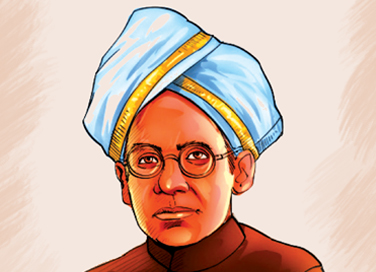
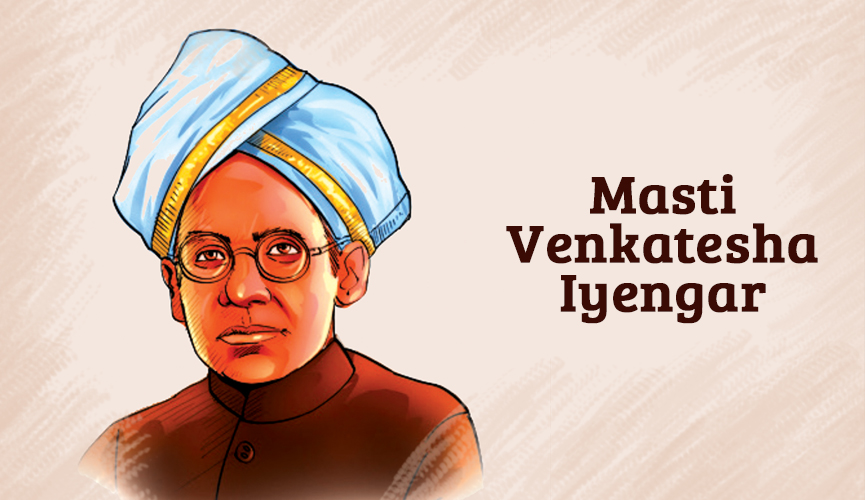
Masti Venkatesha Iyengar was born in a village called Masti, in Kolar district, in 1891. He completed his education in 1914 and joined the civil service. He worked in various positions of high responsibility and was known to be an exceptional administrator. The time he spent in the bureaucratic world helped him later during his literary phase. M. V. Iyengar took voluntary retirement in 1943 and began writing under the pen name ‘Srinivasa’. Most of his writing was inspired by the knowledge and experience he gained during his working years. Known as the forefather of Kannada short stories, his language and style are of the highest literary quality and his themes are rich in thought and contemporary relevance.
In 1983, his historical novel Chikkareera Rafeidra won the Jnanpith award. Masti has written more than 120 books in Kannada and around seventeen books in English. Some of his famous works are Snhhama. Channahavala Nayaka and Chikkareem &Osaka. He also edited a monthly journal, Jeetrina. from 1944 to 1965. Kakana Kale, from which the Amar Chitra Katha story, The Elusive Kaka, has been taken is based on the life of the legendary Kaka Nayaka, who was the leader of the local forest-dwelling Jenu Kuruba community. Masti Venkatesha Iyengar’s writings are steeped in reality and therefore strike an instant chord in the reader’s heart. This legendary literateur passed away in 1986.
Read more about the fascinating literature of India through our title Great Indian Classics. Now available on Kindle, Amazon, Flipkart, and with other major e-tailers.
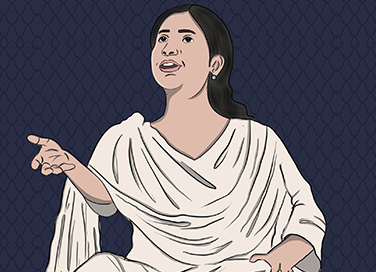
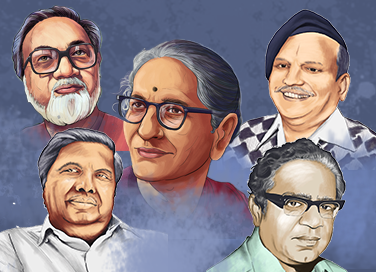
By Krithika Nair
Maharashtra has a rich culture of literature and arts. It has been the birthplace of many legendary names, from the Bhakti poets like Dnyaneshwar and Chokhamela to playwrights like Kusumagraj and filmmakers like Dadasaheb Phalke. While Marathi Sahitya is full of great authors and phenomenal works, here is a list of some important authors whose works are still regarded as some of the best in the field of literature.
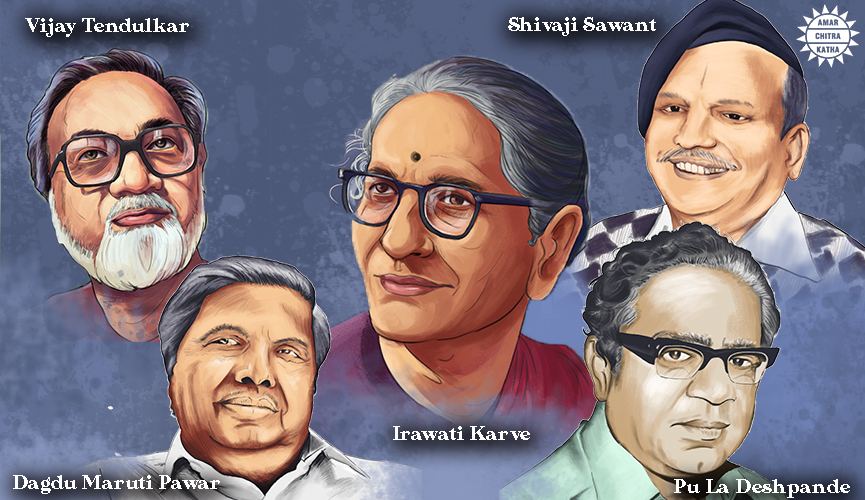
Vijay Tendulkar is one of the most prominent names in modern Indian playwriting. His plays revolve around contemporary social issues and were often inspired by real incidents from the time. He employed many experimental as well as native techniques in his plays. A recurring theme in a lot of his works is violence, be it political or personal. He is best known for the plays Ghashiram Kotwal and Shantata! Court Chalu Aahe, which was also made into a film in Marathi. Apart from being a playwright, Tendulkar also wrote screenplays, novels and short stories. He was honoured with the Padma Bhushan in the year 1984.
Popularly known as Pu La Deshpande or even just Pu La, Deshpande is one of the most iconic authors of Marathi literature. He wrote in different styles and across genres, but he was most loved for his humourous works. Apart from his literary achievements, he was also an actor, singer, musician and composer. He was awarded the Padma Shri in 1966 and the Padma Bhushan in 1990. To honour his invaluable contributions to Marathi Literature, the Government of Maharashtra instituted the P. L. Deshpande Maharashtra Kala Academy in 2002.
Anant Pai, the founder-editor of Amar Chitra Katha, was a student of Deshpande from when he worked as an English teacher early in his life, at Orient High School, Mahim.
Irawati Karve was an anthropologist, educationist and writer whose work is largely academic and based on the study of Maharashtrian culture. She was the daughter-in-law of social reformer Dhondo Keshav Karve. Her most well-known book is Yuganta: The End of an Epoch. The book is an in-depth analysis of the Mahabharata by interpreting it as a historical rather than a mythological text, and using the information to draw conclusions about the social, cultural and political life in India during that time. The book won the Sahitya Akademi Award in 1968. Her other works include Aamchi Sanskruti, Bhovara, Paripurti, Gangajal and many more.
Dagdu Maruti Pawar, better known as Daya Pawar, was a trailblazer in the Marathi literature scene of his time. Credited as the author of what is considered the first autobiography in Dalit Literature, his novel Baluta brought him praise as well as awards. The story of his sufferings as an untouchable is narrated by the young Dagdu Pawar to his older self, the more educated Daya Pawar. The book inspired a wave of autobiographical writing in Marathi, giving voice to many who had similar experiences to share. Pawar was also a brilliant poet. His poems reflected how troubled he was by the personal, political and social circumstances that surrounded him. He was awarded the Padma Shri in the year 1990.
The greatness of Shivaji Sawant’s work is perhaps best reflected by the fact that he came to be known as Mrutyunjaykaar, after his most popular novel Mrutyunjay. The novel is based on the life of Karna, one of the most controversial and intriguing characters from the Mahabharata. Mrutyunjay is regarded as one of the best works in Marathi literature, and was translated to multiple languages. His other popular works include Chhava, which dealt with the life of Chhatrapati Sambhaji Maharaj, and Yugandhar, based on the life of Krishna. Sawant was the first Marathi author to receive the Moortidevi Award, presented by the Bharatiya Jnanpith, in 1994.
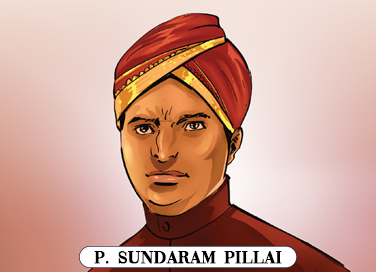
By Shalini Srinivasan, Sanjana Kapur & Gankhu Sumnyan
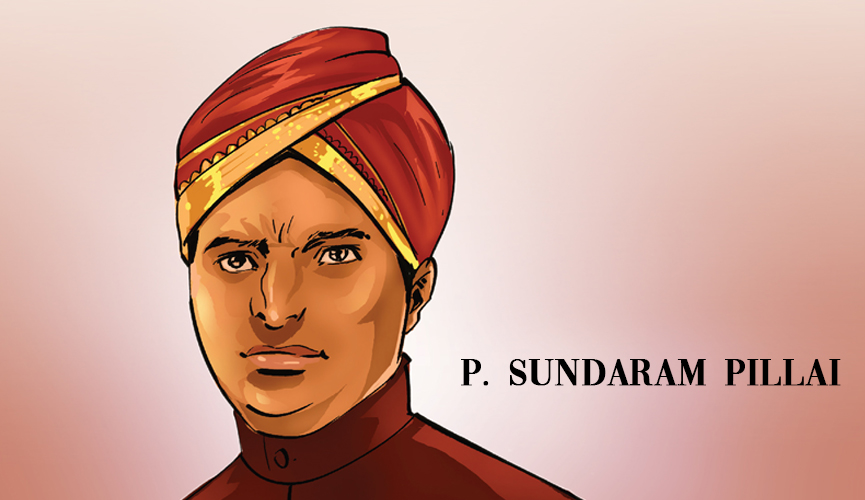
P. Sundaram Pillai was born on the 4th of April, 1855, in Alappuzha, in Kerala, to Perumal Pillai and Madathy Ammal. He was educated in the Tamil literary tradition, reading widely and deeply in classics like the Tirukural. He went to Trivandrum, where he studied in the Maharaja’s College. In 1877, a year after he finished his BA, he was married to Shivagami Ammal. He taught, first at the Thirunelveli English-Tamil School, and later as Professor of Philosophy at his old college. Pillai continued to study and got an MA degree. He also worked for the Travancore Education Service. Sundaram Pillai’s learning was vast – he was familiar with philosophy and literature in Tamil, English, and Sanskrit.
He noticed that though the Tamil language had a rich and ancient literature, there were no plays, not in the Western sense. He set out therefore, to write a great drama in blank verse. The play was called Manonmaniyam and became immensely popular, shortly after it was published in 1891. Though the play is too long to be performed in full, it has been adapted and enacted, and is popular even today. The play also features an invocation to the Tama language, Niraaarum Kadal Udutha, that has been adopted by the Government of Tamil Nadu as the state song.
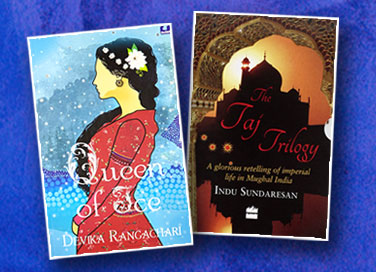
By Krithika Nair
Most of our history talks about valiant kings and wise rulers, but very little is known of their other halves. The royal women lived highly guarded lives, always surrounded by maidens and living behind curtains, becoming voiceless in the larger narrative of Indian history. However, after years, curiosity got the best of our minds and many accounts, both fictional and factual, were written about these elusive yet powerful women. Here are some of our favourite books about Indian queens:
Gayatri Devi was the daughter of the Maharaja of Cooch Behar, who went on to become the Rajmata of Jaipur. The memoir gives us a peek into the life of a royal who witnessed the change in status of royalty in India, as the autonomy was stripped away from them when India became a democracy. The autobiography takes us through the opulence and grandeur of the queen’s life as a princess, and then as the third queen of the Maharaja of Jaipur. The narration is interspersed with anecdotes, introspections and descriptions of the unspoken rules that India’s royalty lived by.
The Taj Mahal Trilogy comprises three books – The Twentieth Wife, The Feast of Roses and Shadow Princess. The first book chronicles the life of Mehrunnisa, the daughter of a nobleman, who goes on to become the twentieth, yet most remembered, wife of the Mughal Emperor Jahangir. The second book deals with her life as an empress and the brewing romance between her husband’s son Khurram and her niece Arjumand Banu Begum, also known as Shah Jahan and Mumtaz Mahal. The third book delves into the life of Princess Jahanara Begum, who, at 16, is deemed empress by her father Shah Jahan after the death of his wife. The trilogy is full of details about the oft-unknown history of the Mughal queens and what went on behind the veil that hid them from the rest of the world.
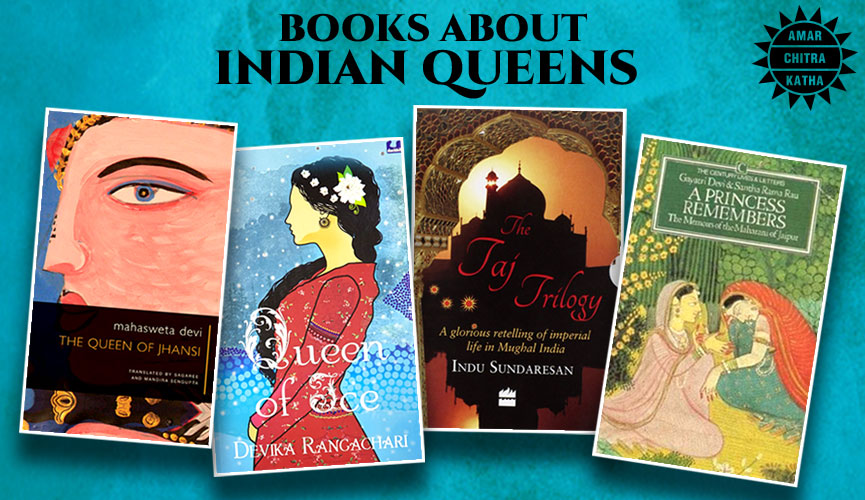
As one of the most iconic leaders in the Indian War of Independence, and perhaps the most well-known queen in India, there are a lot of books about Rani Lakshmibai. Veteran writer Mahasweta Devi’s take on this brave queen’s life is deeply personal and multi-faceted. The book reveals many sides of Lakshmibai – the child, the wife, the queen, the warrior and the mother. Mahasweta Devi’s approach towards the same history from the eyes of the brave queen, gives it a unique perspective and makes it a must-read.
Queen of Ice is a slightly fictional retelling of the story of Queen Didda of Kashmir. Born as the princess of Lohara, the Rajatarangini refers to her as ‘Charanahina’, meaning lacking a foot – lame. Both the author’s voice and the character are refreshing, for Didda is one of the rare Indian queens who are known for their ruthlessness and political acumen, rather than their beauty or grace. The book weaves through the personal and political seamlessly, to tell the story of the queen whose identity is often reduced to that of being a tyrant and nothing more.
The Ivory Throne is a well-researched historical work by Manu S. Pillai. While it largely gives an overview of the Royal House of Travancore, starting from the arrival of the Portuguese in Kerala, the book mainly deals with the life of Sethu Lakshmi Bayi, the senior Maharani of Travancore. The book meticulously records everything from the queen’s regency, political reforms and the conflicts between the Maharani and her sister Sethu Parvathi Bayi, the Junior Maharani, which eventually leads to the struggle for power between the two. The book is a riveting read, rich in historical detail as well as royal secrets.
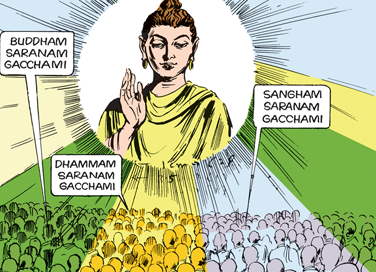
By Aditya Sen and Vijita Mukherjee
Prince Siddharth of the Shakya clan came to be known as Gautama Buddha after he found enlightenment. For this, he left his wife, Princess Yasodhara, his son Rahula and his father, King Suddhodana’s kingdom. Here are some stories associated with his life thereafter.
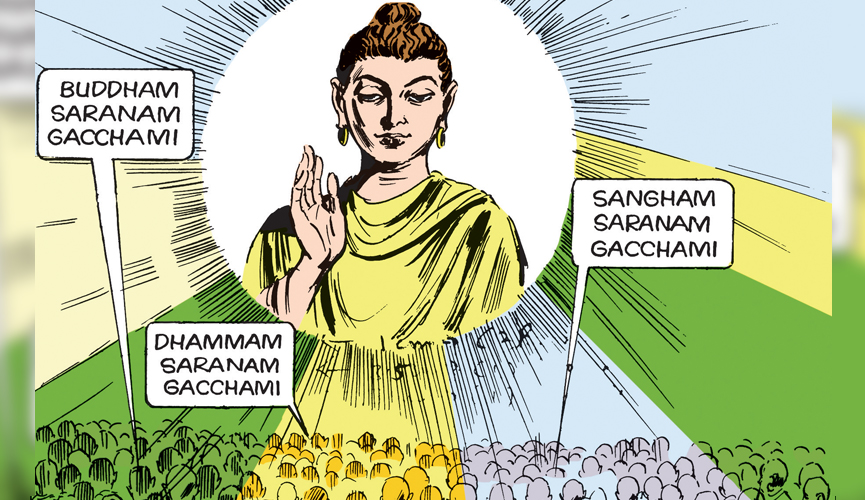
A rich young man named Yashas listened to the Buddha at the Deer Park in Benares. The teachings were so profound that Yashas immediately became a monk (bhikku). In the evening, his father came looking for him fearing that he had been attacked by robbers or worse. On listening to the Buddha, Yashas’s father also became a monk, as did fifty-four of his other friends.
Krishna Gotami, a wealthy young woman, lost her one-year-old son. Overcome with grief, she came to the Buddha and asked him to bring her son back to life. He listened to her with compassion and then said that to perform this feat he needed five mustard seeds from any house where there had been no death. When she went from house to house asking for the mustard seeds, Krishna Gotami realised that suffering and death are inevitable. She became a follower of the Buddha.
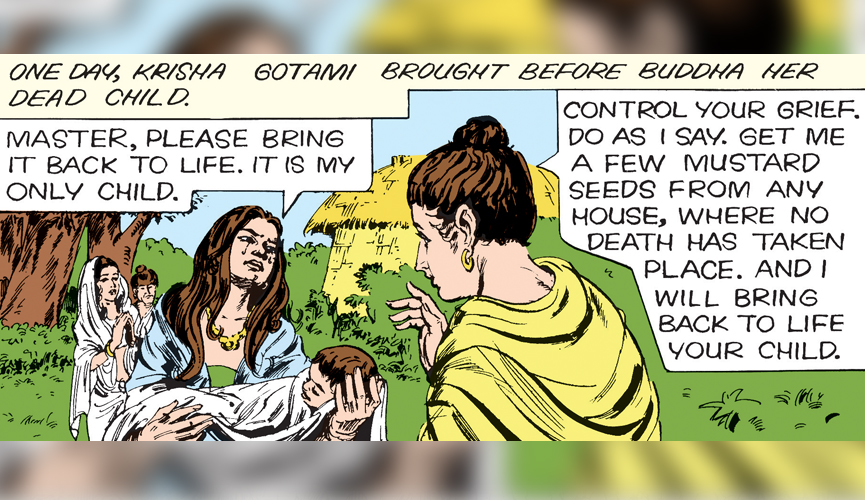
A wealthy Brahmin was harvesting his crop when the Buddha came with the begging bowl in his hands. The Brahmin reprimanded him for begging and told him that he should work for his food. After all, farming was hard work requiring ploughing, sowing, weeding and watering and only after that does one get to eat. The Buddha calmly replied that he too was a farmer. The Brahmin was surprised. “Then where are your bullocks, the seed and the plough?” he asked. The Buddha explained that he sows seeds of faith, his good deeds are the rain, wisdom and good action are parts of the plough, and his mind is the guiding rein. He destroys the weeds of delusion with constant awareness. Finally, he harvests the fruit of Nirvana and ends all sorrow.
Once the Buddha was taking a walk and he saw a herd of goats and sheep. The animals were being taken to the king for a sacrifice. The Buddha affectionately picked up a lamb who was limping and accompanied the herdsman.
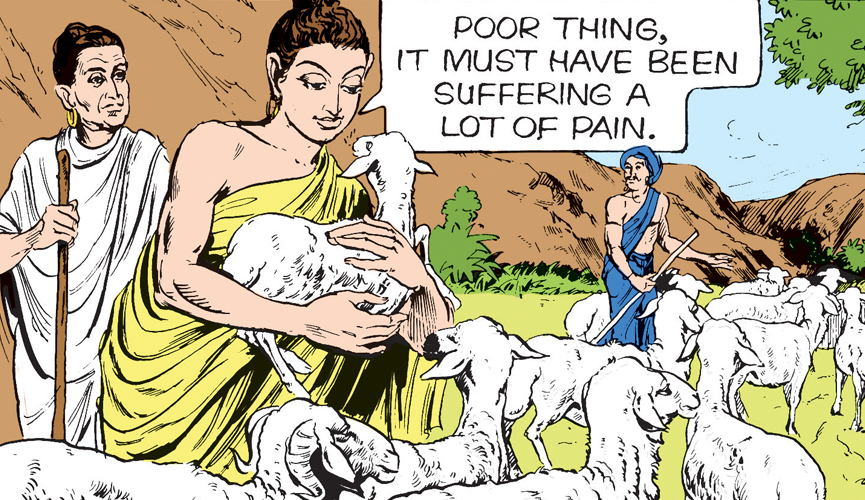
Just as the man in charge of the sacrifice was about to begin, the Buddha intervened and offered his life instead of the poor animals. The king was amazed at these words and asked the Buddha to speak to him and his people.
The Buddha asked the people to remember that though it is easy to take life, none among them had the ability to give life. All life is linked and it is compassion that makes it beautiful.
The king of the land decreed that none in his kingdom shall kill for sacrifice or pleasure.
Gautama Buddha was preaching in Rajagaha when King Suddhodana sent nine messengers, one after the other to call him home to Kapilavastu. All the nine became monks and never returned.
When Gautama finally did come, the people of the city and his family treated him as a brother, nephew, grandson and so on. They still felt bound to the old relationship that they had with him, while he had transcended those boundaries. He performed the ‘Twin Miracle’ there for the first time. Seeing him emit fire from half of his body and water from the other half, they realised who he had become and flocked to him to learn.
Once Gautama came to King Suddhodana’s palace, all the people there came to meet him. However, Yasodhara did not come. The King informed the Buddha that ever since he left, Yasodhara had lived a spartan life. She ate one meal a day, shunned perfumes and ornamentation and wore the robes of an ascetic. The Buddha admired her sacrifice and patience. She entered the Order of Monks and Nuns and attained the state of an arhat.
Thus, Gautama Buddha transformed all the lives he came in touch with and continues to do so even today.
Read the life story of ‘The enlightened one’ in our title Buddha, now available on the ACK Comics App, Kindle, Amazon, Flipkart, and other major e-tailers.
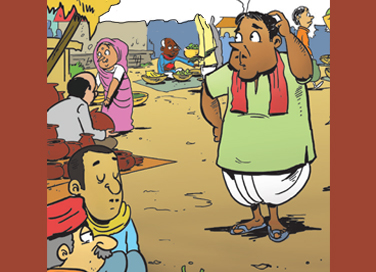
By Komal Narwani
In a tranquil village in Madhya Pradesh, on a quaint morning, Vidyawati made her way to the village well where all her friends also came to fetch water.
“La La Lalalala La Lalala Ley”
“Hello, Vidyawati. Why are you so late today?” said one of her friends.
“I stopped by to admire a beautiful singing bird on my way,” said Vidyavati. “And now I see you all humming a wonderful melody too!”
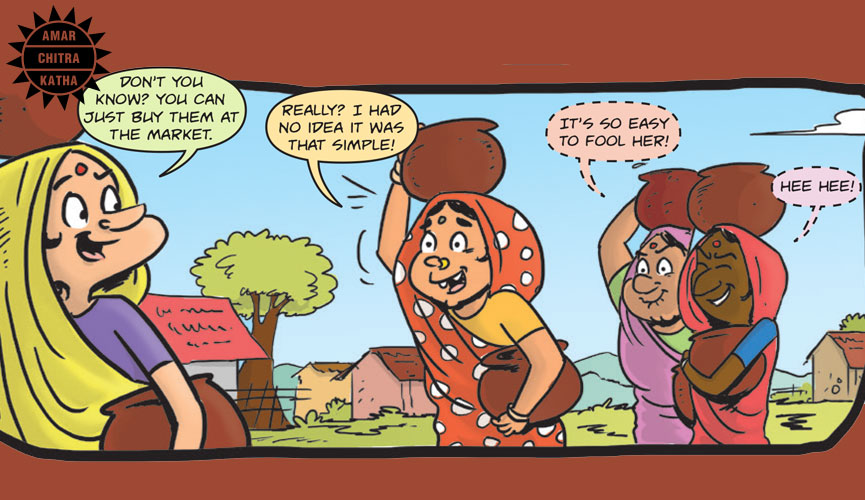
They all giggled and continued singing but Vidyawati did not sing. One of her friends asked her, “Why don’t you sing with us?”
With a sad look on her face, Vidyawati said, “I would love to but I do not know any songs. You all sing so well. Where did you all learn so many songs?”
One of the women said, “Oh! Don’t you know? You can buy them at the market.” When she winked, the others understood that it was a prank and decided to play along. “Is that so? I had no idea it was that simple!” said clueless Vidyawati.
On her way home, she started daydreaming of the morning she would sing with her friends. As soon as she reached home, she called out to her husband, Kantilal, “Dear husband, please get me a song from the market.”
Kantilal was confused; he had never seen any songs being sold in the market! However, Vidyawati insisted. “My friends told me. Please, could you just get me one song from the market? I would love to sing with them.”
Kantilal was a loving husband. He saw how excited his wife was and decided to give it a try, “Okay. I will go and look for a song.”
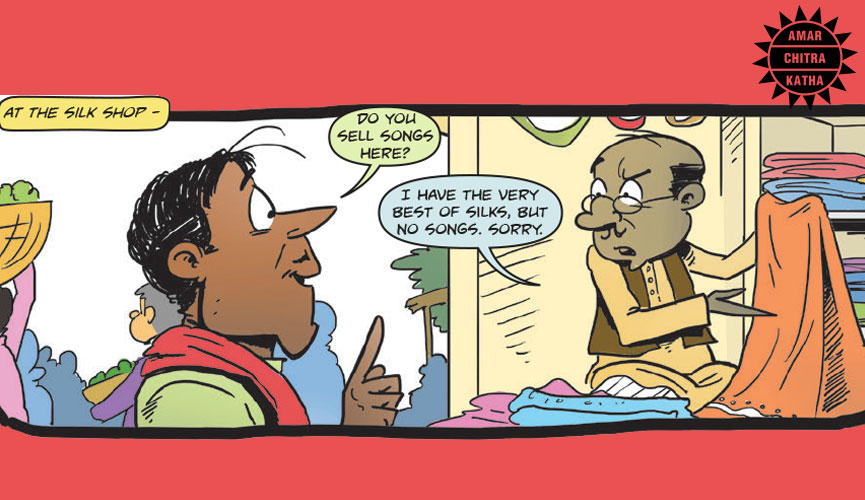
At the market, he went from shop to shop to find out where the songs were being sold. The innocent couple were pranked by many. When Kantilal asked one of the shopkeepers, he said, “Ah! Songs. Yes, we do keep songs but right now we are sold out. The silk shop at the far end might have some.”
“Thank you!” said Kantilal.
As soon as he left, the shopkeeper giggled, “Haha… That should be fun!” At the silk shop when Kantilal asked for a song, the shopkeeper said, “I have the finest of silks, not songs.” Although tired, Kantilal kept searching for songs but obviously, with no luck.
Disappointed, he decided to head home. As he ambled away, he wondered if there was any way to get a song for his wife. Suddenly, it occurred to him!
“Ah! If I can’t buy a song, maybe I can make a song myself,” he thought aloud. “Hmmm… What shall I sing about?” he continued thinking. A rat ran across his path, almost answering his question.
“Why not sing about the rat digging a hole in the ground?
Khode Kharar Kharar
Hmm, yes, that sounds good!”
Pleased with his newly crafted one-line song, Kantilal marched home humming it.
“Khode Kharar Kharar… Hmmm hmmm hmm hmm hmm hm.”
On his way, “Khode khaaaaa… a snake!” he panicked as a snake crossed his path but the snake slid away without noticing him. As he got some relief, “Phew! The snake is just slithering away. Sarke Sarar Sarar. I could add this to my song!”
As he kept humming the song and walking, he noticed a fluffy white hare, behind the bushes, looking at him with sparkling eyes. “Such a cute bunny looking at me. Dekhe Tagar Magar. Oh! Another line!”
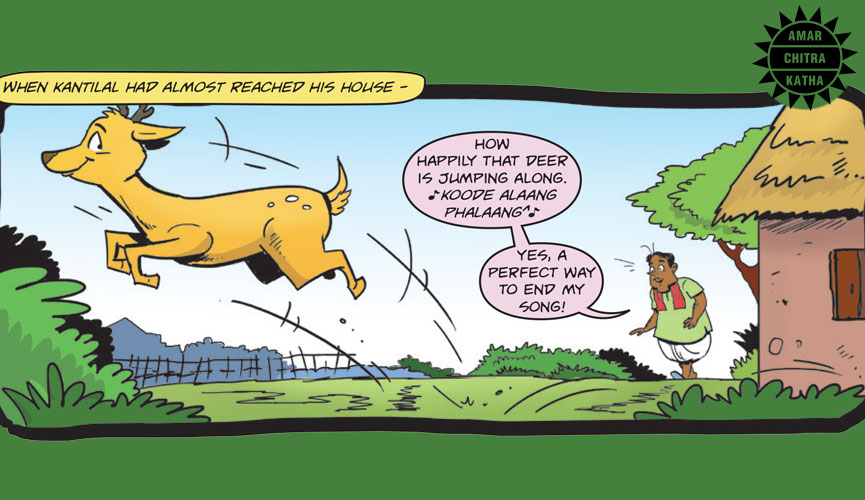
When Kantilal had almost reached his house, he saw a deer merrily jumping along. “I think I have got the perfect ending to my song. Koode Alaang Phalaang.”
“Khode Kharar Kahar
Sarke Sarar Sarar
Dekhe Tagar Magar
Koode Alaang Phalaang”
“Vidyawati will be so happy,” he said to himself as he knocked on the door. Vidyawati was too anxious. As soon as she opened the door, she asked, “Did you find a song, husband?”
With a sparkle in his eyes and a wide smile on his lips, Kantilal proudly replied, “Yes, my dear, I bought the most expensive song I could find!”
Vidyawati was overjoyed to hear that. She could not contain her excitement and sat to learn the song at once.
“Khode Kharar Kahar
Sarke Sarar Sarar
Dekhe Tagar Magar
Koode Alaang Phalaang”
The couple sang the song many times. Vidyawati did not seem to get tired of practising. At night, Vidyawati went to bed but kept tossing and turning. She was too excited to sleep! She wanted to practice the song again to make sure she remembered it. Swiftly, she got out of bed, went into the kitchen and started practising the song. She realised that there was some corn left to be ground. Making the most of her time, she started grinding corn and practising the song.
“Khode Kharar Kahar…”
“No, no. Is this how my husband sang? Let me sing that line again. I want to practice the song perfectly. I am so excited to sing it with my friends tomorrow morning,” she thought to herself.
In the village, there lived a thief named Dhanga, a man with wide eyes and a pointy-long nose. Every night, he would prowl through the village. That night, Dhanga decided to sneak into the house of Vidyawati and Kantilal.
Digging a hole in the wall, Dhanga thought “That last house was useless. All I got was a few coins and a bag of clothes. This house looks full. I hope I get a little gold in this one.”
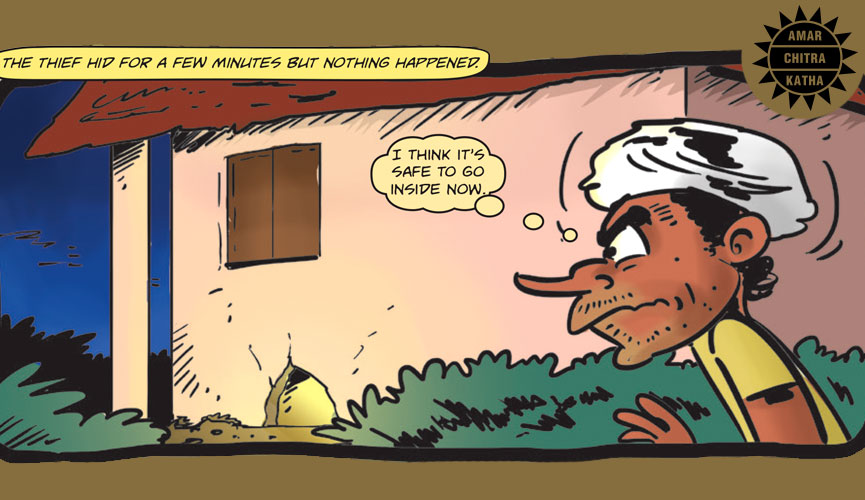
Just then, he heard Vidyawati sing, “Khode Kharar Kahar…”
“Oh no! Did somebody see me digging? Let me quickly hide behind the bushes to make sure,” he feared.
Few minutes passed but nothing happened. Dhanga thought it was safe to resume. He crept inside the house through the hole.
Vidyawati continued, “Sarke Sarar Sarar…”
He was startled to hear that but he observed Vidyawati and realized she was busy grinding corn. Assuming she didn’t see him, he decided to make the next move. But –
“Dekhe Tagar Magar…”
THUD!
He panicked and hurt himself as he struggled to get out through the tiny hole. “She saw me…She definitely saw me otherwise she wouldn’t have said that. What’s more, it’s as if she can read my mind! I need to get out of here now!” he thought.
Meanwhile, unaware of Dhanga’s presence, Vidyawati merrily sang, “Koode Alaang Phalaang.”
“Aaghh! How is she still watching me? I shall never come to this house again.” Saying so, Dhanga ran for his life.
The next morning, Kantilal was stunned to see a hole in the wall. He thought that they had been robbed but to his amazement, he found the valuables untouched. Nothing was stolen from the house. He called out to Vidyawati, “Vidyawati, did you notice there is a hole in the wall? I think somebody broke into the house but surprisingly nothing was stolen. What were you doing last night? Didn’t you stay awake for a while?”
“I was practising the nice expensive song you bought me,” said Vidyawati.
Kantilal laughed, “Haha! I think it must be a very good song. After all, it has scared a thief away from our home.”
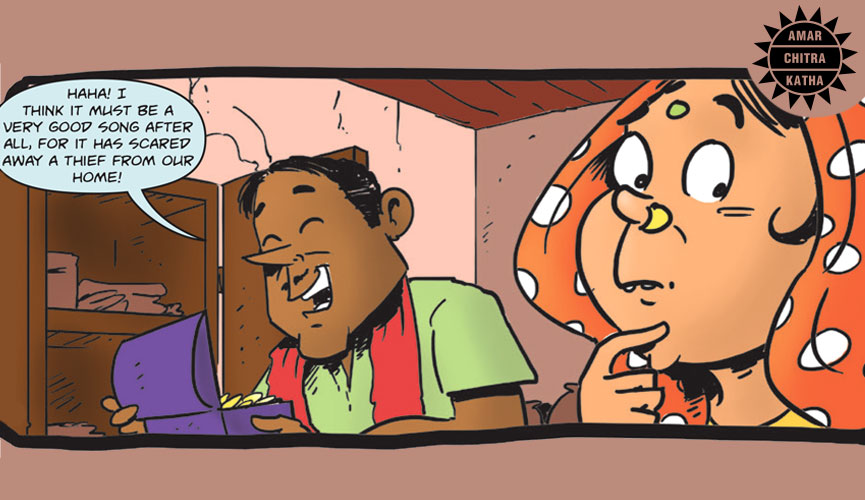
Later that day when Vidyawati met her friends, she happily flaunted the song to her friends. “My husband bought me a nice expensive song from the market, just like you said! It even scared away a thief from my house. Oh, it’s a beautiful song!”
Leaving her friends flabbergasted, she merrily continued,
“Khode Kharar Kahar
Sarke Sarar Sarar
Dekhe Tagar Magar
Koode Alaang Phalaang!”
Read folktales from around India in our title Ranchen the Stone Lion and Other Stories. It is now available on the ACK Comics App, Kindle, Amazon, Flipkart and other major e-tailers.
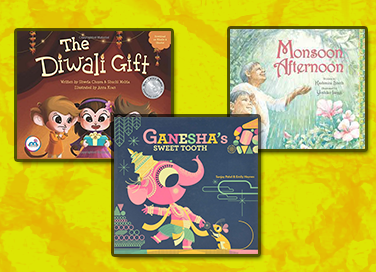
By Pratit Raiturcar and Krithika Nair
Many Indians believe that the world of children’s literature is dominated by ideas and stories from the Western part of the globe. While that may have been true for a long time, the children’s literature scene in India has evolved greatly in the last few decades. Many of these books represent Indian culture through retellings of famous myths, legends and folktales, while some others talk about experiences that are relatable to Indians everywhere. Here are some of our favourite children’s books that do a beautiful job at representing Indian culture:
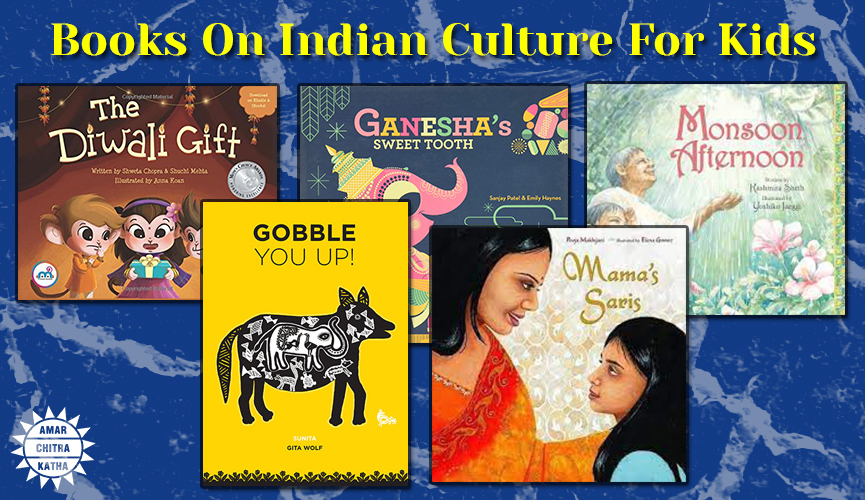
The Diwali Gift is an adorably illustrated children’s book introducing readers to the grand Indian festival of Diwali. Three little monkeys named Suno, Dekho and Jaano get curious about a mysterious gift from Suno’s grandmother. The excited monkeys take guesses on what they think the box contains. The book presents many cultural practices surrounding Diwali through the gift, initiating interest regarding the festival and its celebration. The lively illustrations complement the riddles and rhymes written by the authors very well.
This colourful retelling of the story of the elephant god Ganesha and how he started to write the Mahabharata will definitely introduce the littlest readers to one of India’s greatest stories. Kids will enjoy reading about the magical world of gods and celestial creatures. The beautiful illustrations and fun style of writing make this picture book an absolute winner. The story deviates slightly from the original legend to make it more interesting and funny for the younger audience while retaining the cultural significance of the myth.
Kashmira Sheth weaves a beautiful story about a grandpa and his grandson’s day spent outside during a monsoon. When a little boy notices that it is about to rain, he goes to each family member and asks them to join him to play in the rain. Everyone seems to be occupied until his grandfather finds him looking sad by the door. The boy and his grandfather have fun doing some mundane yet memorable activities such as floating paper boats in a tub until the rain stops. They take a long walk and notice that the ants are gone, the banyan tree’s leaves are shining, and the wild peacocks around the area are dancing, just as they did when the grandpa was just a child, showing how some things remain constant across generations, and how people connect through them.
Imagine dressing up with glamour and having yourself be seen with happiness and wonder while watching the sari caressing the floor perfectly. The child clearly wanted the thrill of having such dazzling looks and what it feels like to be as gorgeous as her mother. When the child looks at her mother’s suitcase filled with cotton and embroidered saris, she decides that she too should wear a sari just like her mama in order to look as beautiful as she does. Mama’s Saris is a peek into the mind of every young girl who wishes to play dress up. This is a beautiful story between a mom and a child and how their bond deepens through their mutual fondness for saris.
Gobble You Up! is a simple, traditional tale about a jackal who makes a fool out of his friend, a crane, by telling him that he is too lazy to hunt for food and proceeding to gobble the crane! The jackal ends up being a hunter and starts to kill and eat every animal that crosses his path; which in turn bursts his stomach open and all the animals he ate are set free. The beautiful style of art, known as Meena art, is a traditional style practised in Rajasthan. The message of the story, that greed always ends in bad consequences, is communicated quite effectively to its young readers.
We, at Amar Chitra Katha, cherish our heritage and always try to represent our culture in its most authentic form. Be it mythology, folktales or history – we have it covered! Check out our vast digital library on the ACK Comics App.
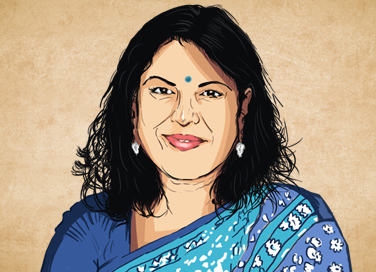
By Mehar Dhillon
Chitra Banerjee Divakaruni embeds within her work the subtleties and complexities of what it is like to be a woman, or to identify as one, in a patriarchal society. This patriarchal society erases the experiences of women and fills the void with an objectified version of a woman, as constructed by the male gaze. Women no longer remain people, but concepts and fantasies. She deploys her skill as a writer to restore these forgotten female voices.
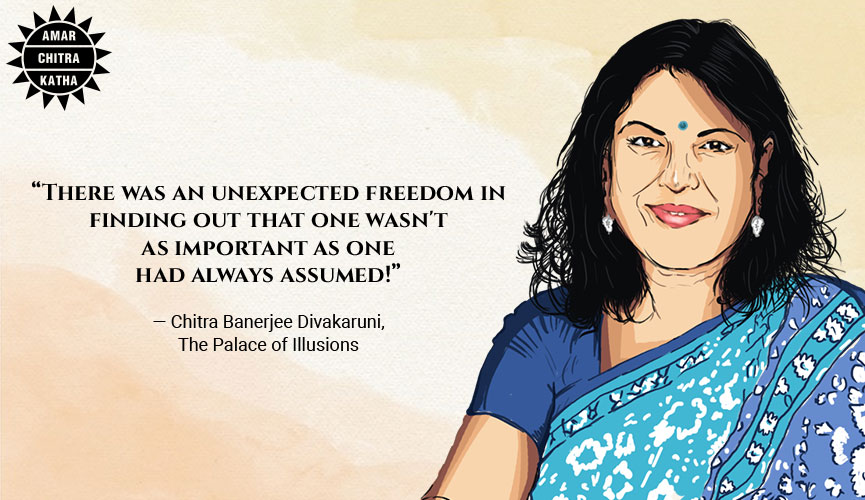
This prolific writer was born in Kolkata, India. She pursued higher studies in the United States and received a Master’s degree in English from the Wright State University in Dayton, Ohio, and a PhD from the University of California, Berkeley.
Her novel, The Forest of Enchantments, is a retelling of the Ramayana but through the eyes of Sita. The story of Sita has always been a subset of the main story of the male protagonists. Such storytelling makes it impossible to accurately depict and explore Sita’s uniquely female experiences and essentially hides her voice. Divakaruni manages to unearth Sita’s voice and pen it down in The Forest of Enchantments, thus adding more depth and nuances to the age-old epic, the Ramayana.
The writer takes the same approach in The Palace of Illusions. In this novel, the half-mythical and half-historical fusion that is the Mahabharata, is reimagined through the perspective of Panchaali, the wife of the five legendary Pandava princes. The novel demonstrates the virtues and qualities this princess possesses and how she becomes a pillar of support for her husbands. It fleshes out her varied emotions as the Pandavas fight to reclaim their throne and also her determination and strength as she takes control of the household from her mother-in-law. Once again, Chitra manages to add more dimensions to an age-old story.
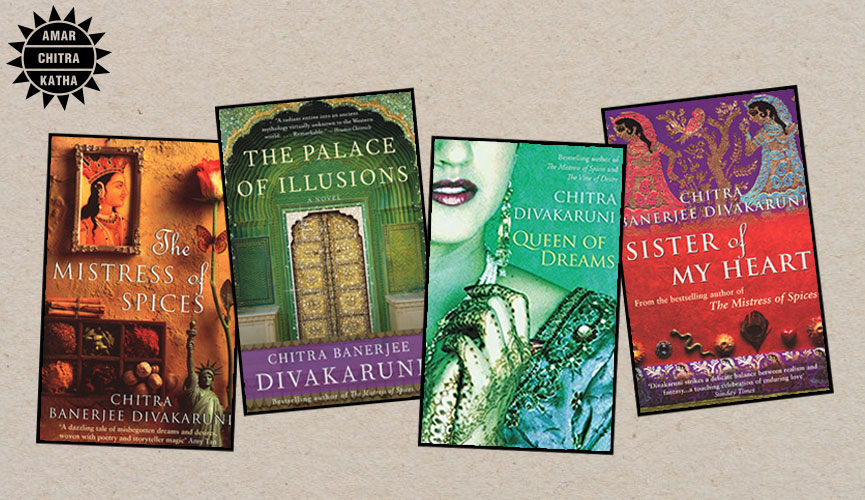
Arranged Marriage is a compilation of many short stories that delve into the experiences which are distinct to Indian women. Most of the stories in this collection follow the dissonance faced by Indian women of different backgrounds as they navigate their way through American culture. Their Indian upbringing, in simple environments, collides with the glamour and abundance of the American way of life. The women in these stories make their own choices as they encounter events that weren’t available to them back in India which pushes them to adapt and evolve in unique ways.
Her work has been syndicated in The Best American Short Stories, The O’Henry Prize Stories, two Pushcart Prize Anthologies as well as The New Yorker and The Atlantic Monthly. She is a recipient of The American Book Award, the Bay Area Book Reviewers Award and the PEN Josephine Miles Award for fiction along with many others such as the Light of India Award, Times of India, 2011, Cultural Jewel Award, Indian Culture Center, Houston, 2009 and more.
Chitra Divakaruni continues to enthral her readers, adding more pieces of work to her repertoire of writing. Her works, ‘The Mistress of Spices’ and ‘The Word of Love’ have been published in the digital medium and both of them have won awards. She continues to push boundaries and expand the portrayal of women in the media. In a world where the feminine is painfully objectified and robbed of all humanity, Chitra Divakaruni excavates the buried and overlooked women of our world.